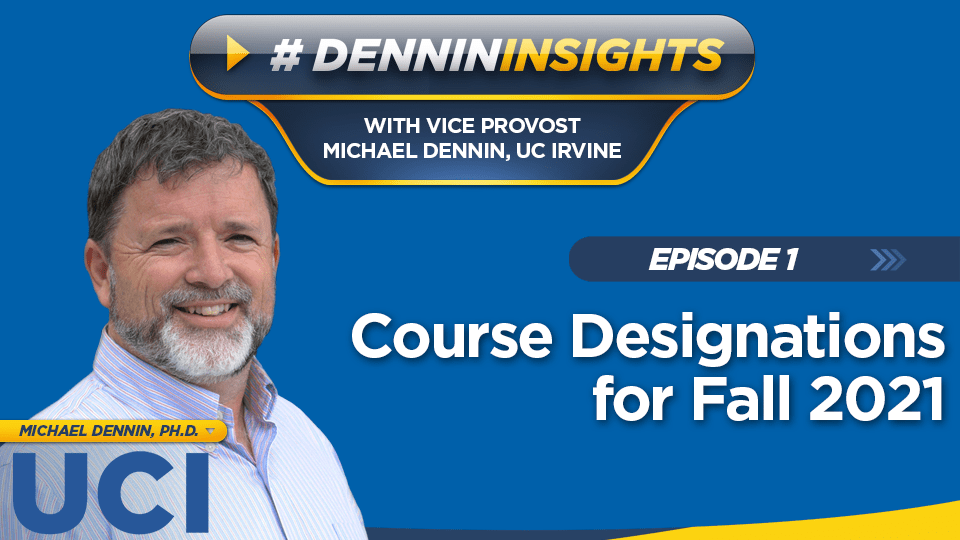
With all the uncertainty we have experienced over the last year due to the pandemic, I think we can all use some stability and consistency. Especially with UC’s recent announcement that we will return to in-person instruction for Fall Quarter 2021, it is important that we are all on the same page regarding what “in-person” entails.
“In-person” might convey the sense that students and faculty will make a return to campus and instruction that reflects “normal,” pre-pandemic activities and experiences. However, I want to emphasize that the expectation at UCI is that we will move beyond a pre-pandemic view of instruction by leveraging lessons learned over the last year.
Our experiences during the pandemic have made it clear that technology in instruction is here to stay, and “in-person” has a whole new meaning. Moving forward, an “in-person” course might involve anywhere from 1-4 hours of an instructor and students meeting at a fixed time and place on campus and another 6-10 hours of experiences that occur in a range of physical and online spaces at set times or completely asynchronously. The main takeaway here is that “in-person” does not mean a total return to pre-pandemic structures—it denotes course structures that leverage live, in-classroom components, synchronous online-components, and asynchronous components. Perhaps the biggest impact is that the return to “in-person” marks a return to informal interactions between students and faculty in physical locations and a significantly increased variety in course modalities!
Given the fluidity and range of potential course designs and experiences, it is helpful to develop some consistent language for a few general categories of delivery modes. During 2021/2022 at UCI, the Academic Senate will be discussing how best to categorize courses and what Senate approvals are needed. Given the Senate waiver of approvals for online instruction for Fall 2021, the following common course designations will be used for Fall 2021 and provide a starting point for discussions.
- In-person: In-person: Requires at least one hour per week of in-person meeting for students with the instructor of record.
- Entirely in-person: traditional classroom with Carnegie Definition of in-person meeting hours (e.g., 3 lecture hours for typical 4 unit course in the quarter system)
- Hybrid: meets for fewer than the Carnegie Definition of in-person meeting hours and has some required remote components. There are many ways the in-person meetings can be configured. For example, a class may require a single, in-person session that is one hour and 20 minutes long and the rest of the class is experienced remotely. In this case, an instructor could choose to schedule it with all the students coming once a week, say on Tuesday, or half the students come on Tuesday and the other half come on Thursday. Either way, a key element of hybrid courses is the fact that the student experience is the same for all students.
- Remote: Has no required in-person meetings, though optional in-person office hours or other opportunities may exist.
- Online: courses specifically designed for online instruction
- Remote-synchronous: traditional lecture or seminar format, with some portion of the course requiring attendance at specific times via Zoom or other remote technology
- Remote-asynchronous: no portion of the course requires students to attend at a particular time. Care needs to be taken as a mostly asynchronous course may have a limited number of required times students must access course material.
- Mixed mode: Course taught in multiple sections, with at least one section in-person and one section remote. “Section” can refer to either multiple lecture sections, a single lecture section with multiple discussion sections, or other combinations.
- Mixed Mode Lecture: There are two likely cases of a mixed mode course at the lecture level. First, for a course that currently has more than one lecture section (each with their own instructor), one of the sections would be remote and one would be in-person. Additional sections would be based on the need for a given modality. Second, a course that traditionally has only one lecture section may require a separate in-person and remote lecture section. These sections would be treated as independent courses from both the perspective of instructors and students.
- Mixed Mode Discussion: A single lecture section for the course that is either remote or in-person (probably remote), with multiple discussion sections. Any particular discussion section is either remote or in-person with instructors only handling either remote or in-person discussions.
As faculty, navigating these various modes of instruction is admittedly challenging. However, when we think of the overall student experience, it is important to remember that the heart and soul of a UCI course is the fact that faculty design and guide students through a learning experience that leverages three core elements:
- Instructor-student interactions
- Student-student interactions
- Student-material interactions
If we focus on these core elements when designing our courses, then the delivery (in-person versus remote) of the courses becomes less of a limitation and more of an opportunity to develop unique, yet still engaging and creative learning experiences for our students. The other core component of a course is access to UCI faculty. Again, the addition of new technologies allows for a wide-range of opportunities for creating this access for students and should be a focus of any course design. Even to the degree possible, designing the informal access to faculty, especially the in-person interactions, should be a consideration in any course design.
As we look forward to the next few years, I envision an exciting time of exploration and creative course design as faculty leverage new tools and competencies to design even more effective, engaging, and fulfilling courses. It is also a time for students to fully engage in the process and share what works best so we can build on their positive experiences as we move forward out of this pandemic era.
If you have any additional questions or concerns, please reach out for assistance.
Recent Comments